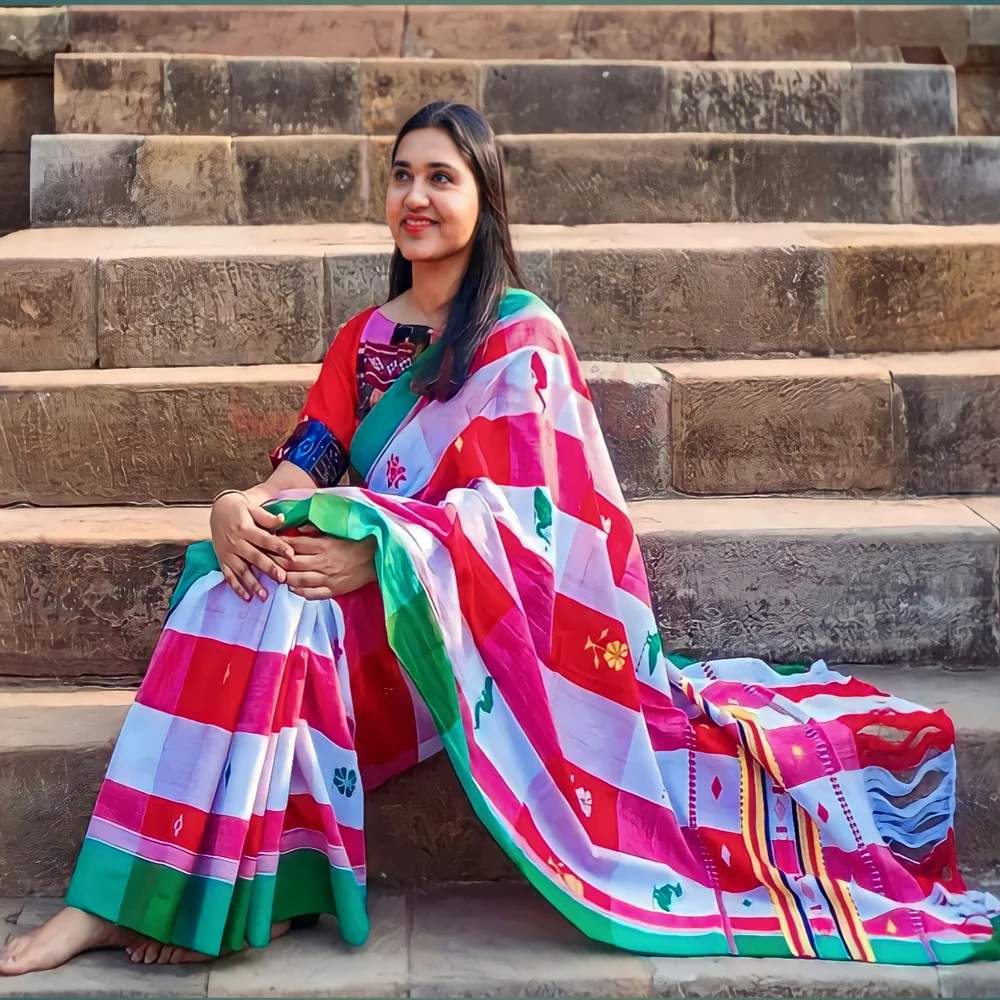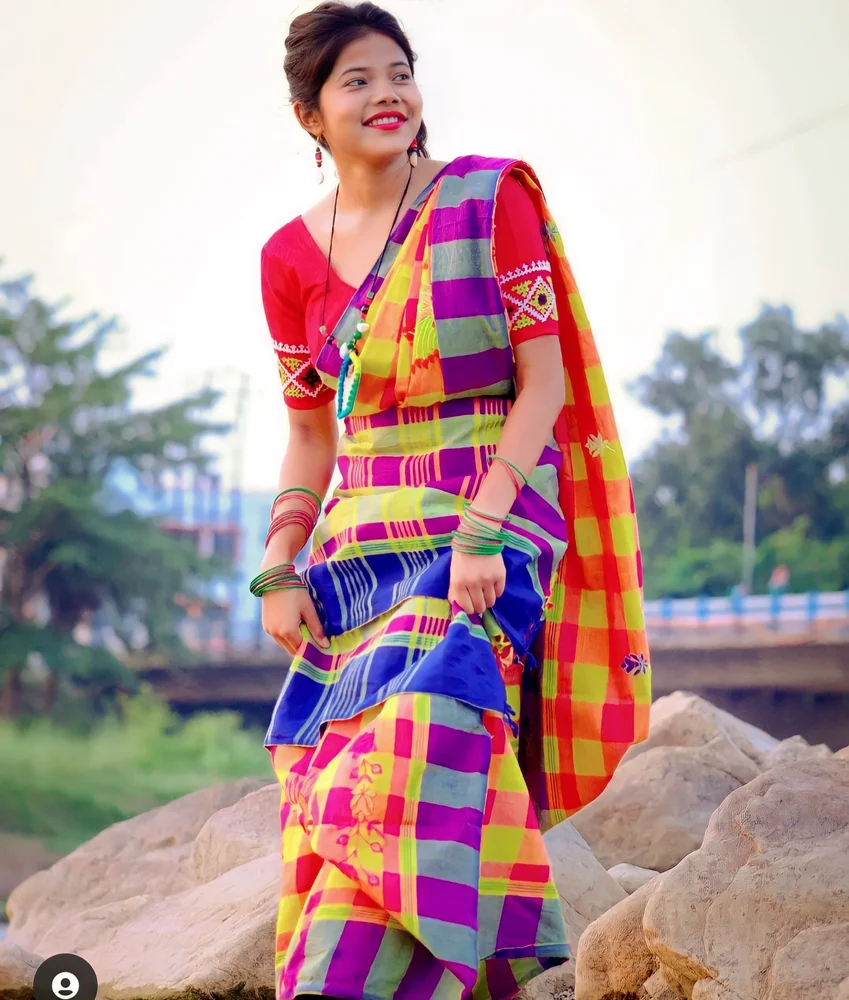Discover the Santali Traditional Fashion Outfit Ideas

The Santali community in the eastern region of India has a rich cultural heritage connected to its traditional fashion. As we enter 2023, it is a great opportunity to celebrate the beauty of Santali clothing, which combines authenticity with modern appeal. Come along on a journey to explore the top 10 Santali traditional fashion outfits, each with a timeless charm that has fascinated generations.
1. Panchi Sharee:
The term “Panchi Sharee” refers to a special type of saree that is significant to the Santali community. Santali women wear the Panchi Sharee during ceremonies, festivals, and weddings. The name comes from the Santali language, where “Panchi” means “bird”. The saree is named after the bird-themed designs woven into the fabric, showing the Santali community’s love for nature. The Panchi Sharee is known for its vibrant colors, traditional patterns, and beautiful borders. It represents the Santali culture and showcases the skill of Santali weavers. Santali women take pride in wearing it to preserve their cultural heritage.
2. Kuli:
In the context of Santali traditional attire, “Kuli” refers to a type of blouse that holds cultural significance among Santali women.
The Kuli blouse is an essential component of the Santali women’s attire, often worn with traditional skirts or sarees. It is known for its unique and intricate designs, reflecting the artistry and craftsmanship of Santali culture.
The Kuli blouse usually has bright colors, fancy stitching, and pretty decorations that show the Santali community’s rich cultural heritage. The patterns on the blouse can be different depending on where you are and what you like, but they often have designs inspired by nature and shapes.
The traditional blouse holds significant importance in the preservation and celebration of Santali identity. It is donned on different festive occasions, ceremonies, and cultural events as a symbol of pride and deep connection to their cultural heritage.
The Kuli blouse is a symbol of Santali traditional fashion and a reflection of the community’s deep connection to their heritage. It holds great value as a cherished garment and remains an important part of Santali women’s clothing. By wearing the Kuli blouse, they honor their cultural legacy and craftsmanship, ensuring its preservation for future generations.
3. Mora:
The text discusses the significance of the Mora necklace in Santali culture. This necklace, made of beads, is a vital part of Santali attire. It is crafted from diverse materials such as wood, stone, or glass and features attractive designs and colors that enhance the wearer’s appearance. Santali women value the Mora necklace as it symbolizes beauty, femininity, and cultural pride.
It is commonly worn during festivals, weddings, and other special occasions to celebrate and adorn oneself. Mora necklaces exhibit different styles and designs based on their origin and individual preferences, reflecting the artistic heritage of the Santali community. These necklaces serve not only as fashion accessories but also as representations of the community’s identity and heritage. The Mora necklace holds great importance in Santali culture as it preserves the tradition across generations and serves as a reminder of the timeless beauty of Santali customs and values.

4. Ghongroo:
In Indian performing arts, the “Ghungroo” is a musical accessory made of small bells tied together. It is commonly used in traditional dance forms like Kathak, Odissi, and Bharatanatyam. The Ghungroo plays a crucial role in enhancing the rhythm of a dancer’s performance.
As the dancer moves their feet, the bells create jingling sounds, adding a mesmerizing melody to the dance. These bells are typically made of brass, copper, or other metals, and they come in various sizes and arrangements, producing different tones. The Ghungroo is securely tied around the dancer’s ankles or feet, with the number of bells varying from a few dozen to hundreds. Apart from the auditory aspect, Ghungroo also visually enhances the intricate footwork and movements of the dancer.
It adds grace and elegance to the presentation, making the performance more dynamic and captivating. Ghungroo has a deep-rooted tradition in Indian dance and has been a vital part of classical performances for centuries. It symbolizes the cultural heritage and artistic expressions of Indian dance forms and is highly cherished by dancers and audiences alike.
5. Topa:
The topa is a traditional Santali hat that is made from bamboo or straw. The hat is typically decorated with colorful beads or feathers. The topa is worn by both men and women, and is a symbol of protection in Santali culture.
6. Aschor:
The aschor is a traditional Santali belt that is made from leather. The belt is typically decorated with colorful beads or metalwork. The aschor is worn by both men and women, and is used to hold up the panchi sharee.
7. Murhu:
The murhu is a traditional Santali musical instrument that is made from a bamboo tube. The tube is typically decorated with colorful beads or feathers. The murhu is played by blowing into the tube and creating vibrations with the lips.
8. Santali Traditional Gamcha
The Santali traditional gamcha is a vibrant and culturally significant textile worn by the Santali community in India. The gamcha is a type of traditional towel or scarf, typically made from cotton fabric and adorned with beautiful patterns and colors. It holds great importance in Santali culture and is an essential part of their daily lives.
The Santali people use the gamcha for various purposes, making it a versatile and practical accessory. They often drape it around their shoulders as a scarf to protect themselves from the sun or chilly weather. It also serves as a towel for drying off after bathing or as a mat to sit on during community gatherings and ceremonies.
9/10.
- Phuta Kacha: “Phuta Kacha” is a traditional lower garment worn by Santali men. It is a type of loose-fitting shorts or breeches that extend up to the knees. The phuta kacha is typically made from cotton fabric and is tied around the waist with a drawstring or a piece of cloth. This garment allows for ease of movement, making it practical for various activities, especially in the rural and agricultural lifestyle of the Santali community.
2. Jhalah: “Jhalah” refers to a traditional shawl or scarf worn by both Santali men and women. It is a rectangular piece of cloth made from cotton or other natural fibers. The jhalah is draped over the shoulders and is often used to cover the head, providing protection from the sun, wind, and rain. It also adds a touch of cultural identity and elegance to the wearer’s attire. Jhalahs are usually adorned with colorful patterns, motifs, and embroidery, representing the artistic and creative traditions of the Santali community.









I believe there are many more pleasurable opportunities ahead for individuals that looked at your site.
It’s an amazing piece of writing for all the internet visitors;
they will obtain advantage from it I am sure.
Greetings! Very helpful advice in this particular article!
It is the little changes which will make the most significant changes.
Thanks for sharing!
Asking questions are truly fastidious thing if you are
not understanding anything fully, but this piece of writing provides pleasant understanding even.
Hi! I know this is somewhat off topic but
I was wondering if you knew where I could get a captcha plugin for my
comment form? I’m using the same blog platform as yours
and I’m having trouble finding one? Thanks a lot!
always i used to read smaller content that also clear their motive, and that is
also happening with this piece of writing which I am
reading at this time.
Wow, amazing weblog format! How lengthy have you ever been running a blog for?
you made running a blog glance easy. The full look of your website is magnificent,
let alone the content material!
If You Need Backlink From Our Site You Have To Pay our minimum Fee of 10$ per Do Follow Backlink And 7$ for No Foolow